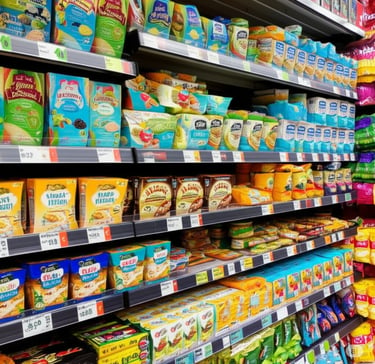The No-Fuss Guide to Reading Food Labels: What 'Low-GI' Actually Means
Trulo team
8/15/20254 min read


You're at the supermarket in Gurugram, navigating the aisles, trying to make healthier choices for yourself and your family. You've heard about the Glycemic Index (GI) and its benefits for stable energy and metabolic health. You might even be eyeing some Trulo goodies! But amidst the colorful packaging and enticing claims, how do you really know if a product is truly "low-GI"?
Fear not, fellow health-conscious shoppers! Decoding food labels doesn't require a science degree. This no-fuss guide will equip you with the essential knowledge to identify genuinely low-GI products, empowering you to make smarter choices with confidence.
The "Low-GI" Buzzword: Beyond the Hype
"Low-GI" is becoming increasingly popular, and while it's a positive step towards greater awareness, it's crucial to look beyond the label's front. Marketing can be clever, and sometimes products might hint at being healthy without truly fitting the low-GI bill. This is where the nutrition information panel and the ingredient list become your best friends.
Your Secret Weapon: The Nutrition Information Panel
Flip the pack and find the table that lists all the nutritional information. Here’s what to focus on when aiming for low-GI:
Total Carbohydrates: This tells you the total amount of carbs per serving. While a lower number can be a good sign, it's not the only indicator of GI. Remember, even some naturally low-carb foods can have a high GI depending on their composition.
Dietary Fiber: This is a crucial number! Fiber slows down the digestion and absorption of carbohydrates, leading to a gentler rise in blood sugar. Generally, look for products with a higher amount of dietary fiber per serving. For a product to be considered potentially low-GI, aim for at least a few grams of fiber per serving. The higher, the better!
Sugars (Including Added Sugars): This line tells you the total amount of sugars, both natural and added. While natural sugars (like those in fruits) aren't necessarily bad in moderation, high amounts of added sugars often contribute to a higher GI. Be wary of products where "sugars" is listed high up in the nutrition panel. Also, look for specific added sugars in the ingredient list (we'll get to that!).
Net Carbs (Sometimes Listed or Calculated): Some labels might mention "net carbs," which is calculated by subtracting the grams of fiber and sometimes sugar alcohols from the total carbohydrates. While not an official term everywhere, it's often used by those focusing on carbohydrate intake. A lower net carb count generally aligns with a lower GI, but always consider the fiber content first.
Pro Tip: Pay attention to the "per serving" size. A product might seem low in carbs or high in fiber, but the serving size could be very small. Adjust your calculations based on how much you actually plan to consume.
The Ingredient List: Unmasking the Hidden Culprits
The ingredient list is where you can see exactly what a product is made of, in descending order of quantity. Here are key ingredients to watch out for when assessing a product's potential GI:
Refined Grains: Be cautious if the first few ingredients include:
Maida (Refined Wheat Flour): A very common ingredient in many Indian snacks and baked goods, and typically high GI.
White Rice Flour: Similar to maida, it lacks the fiber of whole grains.
Semolina (Sooji/Rava - often refined): While some forms can be coarser, refined semolina acts similarly to white flour.
Corn Starch: A highly refined carbohydrate with a high GI.
Modified Starches: Can vary in GI, but often contribute to a higher glycemic response.
Added Sugars (Under Various Names): Sugar goes by many aliases! Look out for:
Sugar (Sucrose)
Glucose
Fructose
High-Fructose Corn Syrup (HFCS)
Corn Syrup Solids
Maltodextrin: Often used as a thickener or filler and can have a high GI.
Any ingredient ending in "-ose" (except cellulose and some sugar alcohols in moderation).
Whole Grains (The Heroes!): Rejoice when you see these listed prominently:
Whole Wheat Flour (Atta)
Millets (Jowar, Bajra, Ragi, etc.)
Oats (especially steel-cut or rolled, not instant)
Brown Rice Flour
Quinoa Flour
The word "whole" preceding the grain is your clue!
Fiber-Rich Ingredients: A longer list of these is a good sign:
Oat Bran
Wheat Bran
Psyllium Husk
Resistant Starch
Inulin
Vegetable Powders or Pieces
Legumes (Lentil Flour, Chickpea Flour)
Decoding Claims on the Front of the Pack
While the back of the label provides the nitty-gritty, the front can offer some initial clues (but don't rely on them solely!):
"Whole Grain": This usually indicates a higher fiber content and potentially lower GI compared to refined grain products. Check the ingredient list to see which whole grains are used and how high up they are.
"High Fiber": Products with a significant amount of fiber per serving are more likely to have a lower GI. Check the nutrition panel for the actual fiber content.
"No Added Sugar" or "Low Sugar": This is a positive sign for managing blood sugar, but remember that the product might still be high in refined carbohydrates. Always check the overall carb and fiber content.
Specific Mentions of Low-GI Ingredients: Some brands might highlight the use of specific low-GI ingredients like millets or certain types of fiber. This can be a good indicator, but still, take a look at the complete nutritional profile.
The Trulo Advantage: We Make it Easy!
At Trulo, we understand the importance of low-GI for sustained energy and better metabolic health. That's why we meticulously craft our products with a focus on whole grains, high fiber content, and minimal added sugars and refined flours. We aim to make it easy for you to choose delicious and truly low-GI options without having to spend hours scrutinizing food labels.
When you pick up a Trulo product, you can be confident that we've done the label reading for you, prioritizing your health and well-being.
Your Journey to Informed Choices
Reading food labels might seem a little daunting at first, but with this guide, you're now equipped with the key knowledge to navigate the supermarket aisles like a pro. By focusing on fiber content, being mindful of refined grains and added sugars in the ingredient list, and understanding the basics of the nutrition information panel, you can confidently choose foods that support your low-GI lifestyle and contribute to a happier, healthier you and your family right here in India. Happy shopping!
